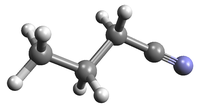|
The anti conformer is about 58 K higher than
the gauche conformer and the later is doubly degenerate
with respect to the former. It has CS symmetry.
Among the 30 vibrational modes, 18 are totally symmetric
(a') and 12 belong to a". The state
v30 = 3 is third lowest in energy. The
transition frequencies were taken from
(1) H. S. P. Müller, A. Walters, N. Wehres, A. Belloche,
O. H. Wilkins, D. Liu, R. Vicente, R. T. Garrod, K. M. Menten,
F. Lewen, and S. Schlemmer,
2016, Astron. Astrophys., 595 Art. No. A87.
Data of v30 = 1 and 2 were fit together
which reduces the number of spectroscopic parameters for
the latter. In addition, v18 = 1 was
included in the fit because of interaction with
v30 = 2. The two states can be separated
because there are only few transitions between the states
which have very large uncertainties.
14N hyperfine splitting as well as CH3
are unlikely to be resolved in astronomical observations.
The predictions may be sufficient for astronomical observations,
but should be viewed with caution if the uncertainties are
larger than 0.3 MHz. In addition, b-type transitions
with Ka ≥ 2 should be viewed with
caution.
Note: the statistical weight of the anti and gauche
conformers is 1 : 2 because of symmetry.
We have estimated vibrational corrections in the harmonic
oscillator approximation using fundamental vibrations
of the gauche-conformer from
(2) J. R. Durig, B. R. Drew, A. Komer, and S. Bell,
2001, Phys. Chem. Chem. Phys., 3 766,
as commented in (1).
Additional information on
vibrational states is also available.
The dipole moment components were assumed to agree with those
in the ground vibrational state of the respective conformer,
see e069505.cat.
|
